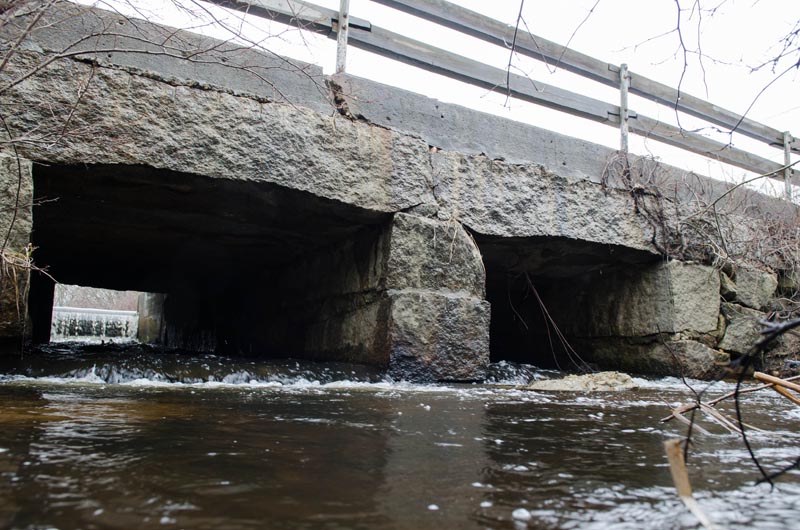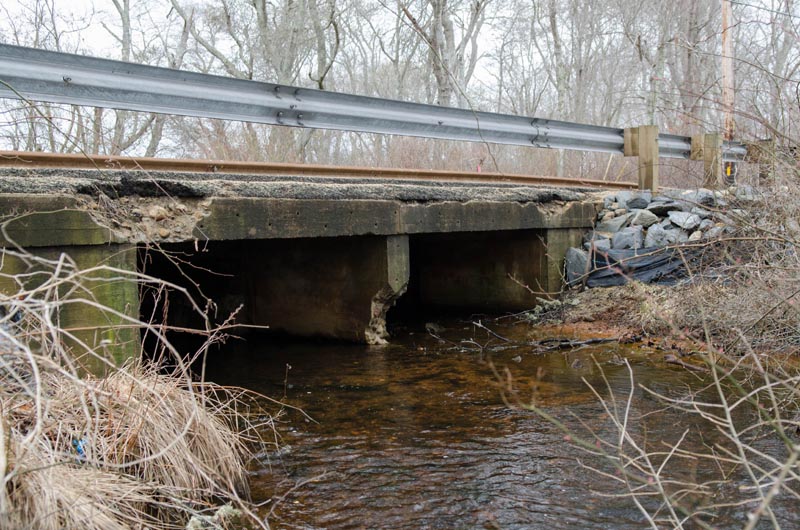West Tisbury voters will again be asked to think of the future of Mill Pond at next week’s annual town meeting, a topic that has been a source of debate in town for several years running.
One warrant article asks for $30,000 in Community Preservation Act funding to pay for the design and permitting of a pond dredging project. Another asks for $15,000 to be added to previous money ($15,000) approved for a hydrology study of the Mill Brook watershed. Both articles are the latest iterations of an ongoing effort to preserve the pond. And there is disagreement about the best way to do that.
“There’s been more or less a continuous background discussion on the condition of the Mill Pond and what should happen to it,” West Tisbury selectman Richard Knabel said. “It’s not sudden at all.”
“People continue to find it controversial,” he said.
Mill Pond is the largest body of water in a complex freshwater river system that flows into the Tisbury Great Pond. The Mill Pond was created in the mid-1600s when the Mill Brook was dammed as a source of hydropower for wool and grist mills along its banks. Today, the pond is best known as the home of mute swans, Canada geese and otters. The pond is stocked each spring with freshwater trout and is a popular fishing spot for families and children.
“It’s [actually] not a pond at all, it’s a widening of the brook,” said Kent Healy, a civil engineer and West Tisbury resident who has been caretaker of the dam for the past 10 years.
Concern about the pond initially arose after a prolonged dry spell on the Vineyard caused the water level to drop.
Since then the town has commissioned studies, formed a committee and held numerous public forums to address the future of the pond. Mill Pond has been a regular item on both annual and special town meeting warrants.
“It’s a man-made pond and like all man-made ponds, they need maintenance,” said Bob Woodruff, chairman of the Mill Pond committee. The committee was formed by selectmen in 2008 and came to the consensus in 2010 that the pond should be dredged to remove accumulated sediment and vegetation. Dredging would deepen the pond, Mr. Woodruff said, and improve the habitat for the plants and animals that live there. He remembers the last time the pond was dredged, in 1970.
“This is about the average time span as far as we can tell, back in time,” Mr. Woodruff said.
Dredging the pond was first recommended by the engineering firm ESS, which conducted a study of the pond in 2006 and 2012. The 2012 study said the cost of the dredge work, including design and permitting costs, would be about $400,000. Mr. Woodruff said dredging would deepen the pond from its current average depth of 1.8 feet.
An article on the annual town meeting warrant this year asks for $50,000 to pay for design and permitting. CPC money would contribute $30,000, with the remaining $20,000 coming from a number of residents who have already pledged funding.
“There are people who are willing to put money into it,” selectman Cynthia Mitchell said. The group is loosely defined as abutters to the Mill Pond, she said.
Funding for actual dredging is not on the warrant.
“For anything to go further, the town would have to vote on that again,” Mr. Knabel said.
But there is some disagreement about the best course of action, even among pond committee members. Mr. Healy believes firmly that the pond does not need to be dredged at all.
“I’m on the committee, but I’m a minority of one,” he said. Mr. Healy has been measuring Mill Pond flow for 25 years. He measured pond depth in 2005 and 2010 and said he had “found to my surprise that in fact the pond was not filling in, but it was getting deeper.”
He said he hoped to remeasure the pond before town meeting next Tuesday.
And then there is a third option, introduced some time ago by Prudy Burt, a town resident and member of the conservation commission. Ms. Burt is advocating that the town remove the dam entirely and allow the area to revert to a natural state.
Ms. Burt hosted a forum last weekend to hear the results of a 2012 Mill Brook fisheries study conducted by Steven Hurley, a district manager for the Massachusetts Division of Fisheries and Wildlife. Mr. Hurley also presented preliminary results from a Mill Brook water temperature study begun last year. The temperature study is funded by an Edey Foundation grant Ms. Burt received.
The combined results of the studies indicated a self-sustaining population of wild brook trout in Mill Brook, but also found that temperatures in the brook were rising. Brook trout require cold water of at least 56 degrees in order to thrive, Mr. Hurley said.
“Everyone’s aware in West Tisbury that we’ve been talking about our Mill Pond and what to do, if anything needs to be done,” Ms. Burt said at the forum. She said she hoped to broaden the conversation. “What were any other options — was there anything to do with Mill Brook, was there more to learn about the fisheries?
“I would like the conversation to expand to not just talk about dredging, but to think outside the box,” she said.
Mr. Hurley said removing the dam would have to account for the populations of American brook lamprey, a rare species that lives in the lower Mill Brook area.
Any future action taken on Mill Pond is contingent on the completion of a watershed study. The study has been on the table for some time in West Tisbury but has not yet started because more funding is needed.
“We needed to understand the hydrological situation of the watershed better than we do,” Mr. Knabel said. “Where the water comes from, in what quantities, and then where does it go in what quantities. That was the original intent.”
“It’s a fairly complex system, and it’s also quite large,” he said.
Funding for the study was approved at town meeting last year, but an initial request for proposals was unsuccessful. Selectmen plan to readvertise the study, which will take a year to complete.
Mr. Woodruff agreed the watershed study is an important step, but he said it does not preclude maintaining the pond by dredging — which he says is urgently needed.
Mill Pond is “an iconic feature of the town,” Mr. Knabel said. “We spend a lot of time and effort worrying about the character of [the] historic district, so it’s quite relevant that we worry about the Mill Pond.”










Comments (2)
Comments
Comment policy »